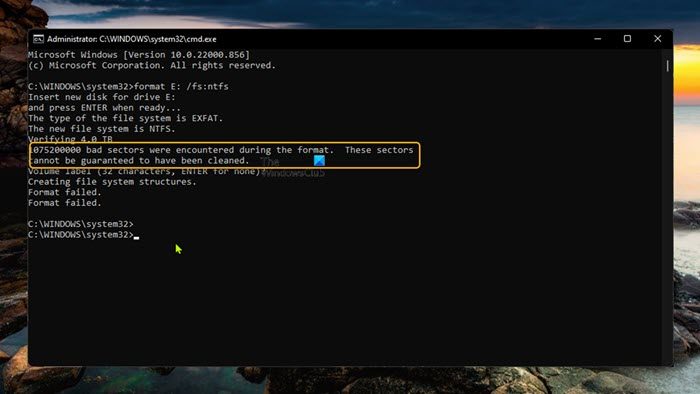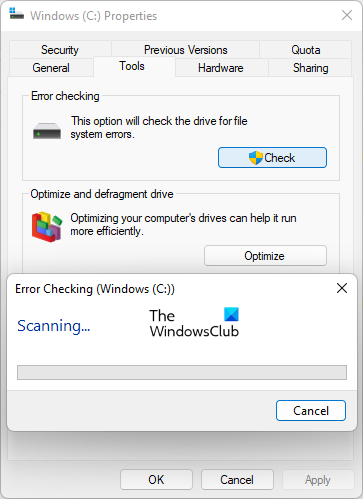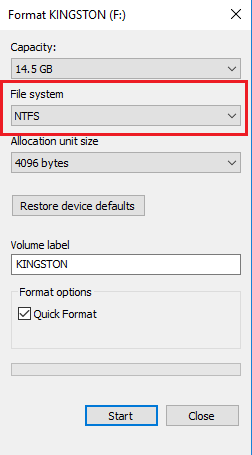When you run the format command in Command Prompt to format a drive on your Windows 11 or Windows 10 computer, the format operation may fail or be unable to complete and output the message Bad sectors were encountered during the format. In this post, we outline steps you can take to remove these bad sectors on the drive and get the storage device to normal working condition, and if need be recover data on the drive.

You will receive the following similar output when the error occurs on your system.
1075200000 bad sectors were encountered during the format. These sectors cannot be guaranteed to have been cleaned.
Volume label (32 characters, ENTER for none)?
Creating file system structures.
Format failed.
For some affected PC users, after the initial format failed, and they tried again, the command prompt reported the drive format as RAW. In this case, refer to the guide on how to fix the RAW partition in Windows 11/10.
Now, before we get right to the task at hand, here’s a quick primer!
A sector is a subdivision of a track (a circular path on the surface of a disk) on your hard disk that stores a fixed amount of data. A bad sector is a sector that appears to be defective and won’t respond to read or write operations. There are two types of bad sectors viz:
- Logical Bad Sector (Soft Bad Sectors)
- Physical Bad Sector (Hard Bad Sectors)
Logical bad sectors are generally caused by software errors like a sudden shutdown of your computer and virus attacks. In most cases, if the operating system finds the error-correcting code doesn’t match the contents of a drive sector when reading data from the sector, the sector will be marked as bad. That notwithstanding, logical bad sectors can be repaired using inbuilt tools that ship with the Windows OS. On the other hand, the physical bad sectors are caused by physical damage to the hard disk itself. This type of bad sector cannot be repaired using the conventional disk repair tools native to the OS or provided by the HDD/SSD hardware manufacturer.
Apart from the obvious output stating bad sectors were encountered, the following are general signs or symptoms of bad sectors in an SD card or USB flash drive, or HDD/SSD:
- Can’t read from the source file or disk.
- The location is not available.
- Unable to complete the format.
- A disk read error has occurred.
- SD card shows empty or 0 bytes.
- SD card is not recognized by the camera, smartphone, or computer.
- You are unable to read or write an SD card.
- Computer asks to format the SD memory card to access it.
The following are reasons why your drive may develop bad sectors:
- Virus infection in the storage media or the computer itself.
- The drive is old and has completed its read/write cycles.
- The same drive (in the case of external drives) is used in multiple devices.
- Improper insertion and ejection of the drive from the computer.
- Removing the SD card without turning off the smartphone or camera.
- Sudden power failure or system shutdown while transferring files or viewing SD card or drive data.
- Low-quality SD card.
- Physical damage, dust, or moisture on the SD card.
Read: Scan drive for errors notification keeps appearing in Windows
Bad sectors were encountered during the format; How to remove them?
If you receive an output with the message Bad sectors were encountered during the format when a drive format operation fails on your Windows 11/10 system, you can apply our suggestions described below to remove the bad sectors present on the drive and restore the drive health to ensure data integrity is maintained on the drive so as not to suffer data loss now or in the foreseeable future.
- Run CHKDSK
- Format the drive on another computer
- Replace drive
Let’s see these suggestions in detail. Before you attempt any repair on the drive, for preventive purposes to avoid data loss, assuming the drive contains important data that you do not have a backup copy, you can use a free data recovery software like the MiniTool Power Data Recovery to attempt recovery of files/data residing on the drive.
1] Run CHKDSK

You can check the hard disk for errors, health, and bad sectors in Windows 11/10 via the graphical interface or the command-line version by following these steps:
- Press the Windows key + R to invoke the Run dialog.
- In the Run dialog box, type cmd and then press CTRL + SHIFT + ENTER to open Command Prompt in elevated mode.
- In the command prompt window, type the command below and hit Enter.
chkdsk g: /x /f /r
Where:
- /f switch tells CHKDSK to fix any errors detected.
- /r switch Identifies Bad Sectors and attempts recovery and restores readable information.
- /x switch forces the drive to be unmounted before the process starts.
- g: represents the letter for the drive you want to check for errors.
You will receive the following message:
CHKDSK cannot run because the volume is in use by another process. Would you like to schedule this volume to be checked the next time the system restarts? (Y/N).
Tap the Y key on the keyboard and then reboot your computer to let CHKDSK check and fix the errors on the computer’s hard drive. Alternatively, you can use CHKDSK alternative disk error-checking software to repair bad sectors.
Read: DiskPart error, Data error cyclic redundancy check
2] Format the drive on another computer

As reported by some affected PC users, for some weird reason, they were able to resolve the issue at hand and complete the drive format operation without bad sectors by formatting the storage media on another computer. Provided you were able to recover the partition on the storage media using a free Partition Recovery software like TestDisk, you can follow the steps below to format the drive as NTFS.
- Insert the USB flash drive into the USB port.
- Open Device Manager.
- Find Disk Drives and expand them.
- Find the USB flash drive you want to format and double-click to open the Properties dialog box.
- Click the Policies tab.
- By default, the Optimize for quick removal option is selected, switch it to Optimize for performance and then click OK.
- Exit Device Manager.
- Next, open File Explorer.
- Right-click on the USB Flash Drive and select Format.
- In the Format dialog box, select NTFS in the File system field.
- Click the Start button and wait while the process will be completed.
Once done, your USB drive should now be formatted as NTFS for your Windows system.
Read: Diskpart has encountered an error, The media is write protected
3] Replace the drive
Although, if you want to continue using a hard disk with physical bad sectors (not recommended) which is technically unrepairable, what you can do is use some third-party tool to block these sectors on the hard disk and prevent the system and programs from attempting to write to these identified bad sectors. You can run the S.M.A.R.T. Test to detect and report various indicators of drive reliability with the intent of anticipating imminent hardware failures. Nevertheless, it’s best recommended to get a replacement healthy drive.
Read: Fix Hard Drive Error Code 2000-0146 on Windows computer
I hope this post helps you!
Now read: Invalid media or Track 0 bad – disk unusable
Can formatting fix bad sectors?
Technically, bad sectors can’t be repaired, so formatting a drive with bad sectors won’t repair the sectors. However, formatting should identify the bad sectors and prevent data from being written on them. But keep in mind though that if you do have bad sectors, it may be that the hard drive is about to fail.
Read: Windows is stuck on Repairing disk errors, This might take an hour to complete
Does CHKDSK remove bad sectors?
Typically, PC users will encounter bad sectors in two forms which are soft bad sectors, which occur when data is written badly, and the hard bad sectors which occur because of physical damage to the disk. CHKDSK attempts to fix these problems by repairing soft bad sectors and marking hard bad sectors, so they won’t be used again.
Read next: The disk does not have enough space to replace bad clusters.